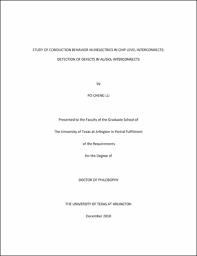
ATTENTION: The works hosted here are being migrated to a new repository that will consolidate resources, improve discoverability, and better show UTA's research impact on the global community. We will update authors as the migration progresses. Please see MavMatrix for more information.
Show simple item record
| dc.contributor.advisor | Yum, Kyungsuk | |
| dc.creator | Lu, Po-Cheng | |
| dc.date.accessioned | 2019-02-26T21:01:39Z | |
| dc.date.available | 2019-02-26T21:01:39Z | |
| dc.date.created | 2018-12 | |
| dc.date.issued | 2018-12-18 | |
| dc.date.submitted | December 2018 | |
| dc.identifier.uri | http://hdl.handle.net/10106/27770 | |
| dc.description.abstract | This dissertation presents four different electrical measurement techniques to detect structural defects in Al/SiO2 interconnects. These techniques, namely 1) polarity dependence measurement, 2) current voltage measurement, 3) two-point measurement and 4) discharge transient current measurement, can provide simple electrical parameters having direct relationship to defects state (type and quantity) in interconnect structure. All these measurement techniques use the MIM (metal-insulator-metal) structure such as the comb-serpentine structure commonly existing in integrated (IC) devices. This study also presents a newly discovered dielectric failure mechanism, that is the failure by a process of partial discharge dielectric breakdown phenomenon.
The goal of the charging polarity dependence measurement is to obtain a self-referenced parameter indicative of structural defect distribution in metal lines. Electrical bias from two opposite direction is applied to sample (one direction is refer to positive bias, while opposite direction is refer to negative bias) in sequence and resulting leakage current is measured. In an ideal situation where metal/dielectric interface is defect free, the leakage current from both bias directions is expected to be identical because leakage current is proportional to electron injection area between metal and dielectric. With no defect, electron injection area from both electrodes are the same. However, if there exist defects in one side of metal line (either comb or serpentine side) more so than the other, electron injection area from both directions will be different, which will result in a net difference in leakage current. Based on this principal, by measuring leakage current difference under different bias direction, uneven distribution of interface defects can be characterized. This measurement can be extended to quantify the interface defect density, more specifically the voids in metal line, by conducting I-V measurement and comparing the forward and reverse current. The voids have two effects. Firstly, it reduces the interface area where electron injection occurs. Hence, injection of electron from this interface makes the leakage current to be smaller. On the other hand, since the void increases the local electrical field, it enhances the electron injection and thus current. Our study finds that the first effect is dominant when the field is low and the latter is more dominant when the field is high. Therefore, IV characteristics of the forward and reverse current shows that the interface with defect produces lower current (than the other direction) at low filed while the opposite happens when the field is high.
As for discharge transient current measurement, it gives a simple parameter that indicates the amount of structural defects in dielectric layer. Source of transient current observed in the research is likely impurities trapped in dielectric during deposition process. Upon bias, impurities are ionized and become mobile ions drifting in the direction of field to reach steady state (full polarization). When electric field is removed (short to ground) during discharging process, mobile ions return to equilibrium and generate discharge transient current. If there exist structural defects in dielectric, ion migration is hindered, resulting in a smaller amount of ion drift and thus the transient current. It is therefore reasonable to relate the total amount of transient charge (Q) to the defect density in dielectric layers. Our study confirms that there exists such a relation and that Q can be used as an indicating parameter for TDDB (time dependent dielectric breakdown) reliability of the dielectrics. | |
| dc.format.mimetype | application/pdf | |
| dc.language.iso | en_US | |
| dc.subject | Reliability | |
| dc.subject | Aluminum interconnect | |
| dc.subject | Dielectrics | |
| dc.subject | Conduction behavior | |
| dc.subject | Electrical measurement | |
| dc.subject | Stress voiding | |
| dc.subject | Partial discharge dielectric breakdown | |
| dc.title | Study of Conduction Behavior in Dielectrics in Chip Level Interconnects: Detection of Defects in Al/SiO2 Interconnects | |
| dc.type | Thesis | |
| dc.degree.department | Materials Science and Engineering | |
| dc.degree.name | Doctor of Philosophy in Materials Science and Engineering | |
| dc.date.updated | 2019-02-26T21:01:39Z | |
| thesis.degree.department | Materials Science and Engineering | |
| thesis.degree.grantor | The University of Texas at Arlington | |
| thesis.degree.level | Doctoral | |
| thesis.degree.name | Doctor of Philosophy in Materials Science and Engineering | |
| dc.type.material | text | |
| dc.creator.orcid | 0000-0003-3565-9449 | |
Files in this item
- Name:
- LU-DISSERTATION-2018.pdf
- Size:
- 25.38Mb
- Format:
- PDF
This item appears in the following Collection(s)
Show simple item record


